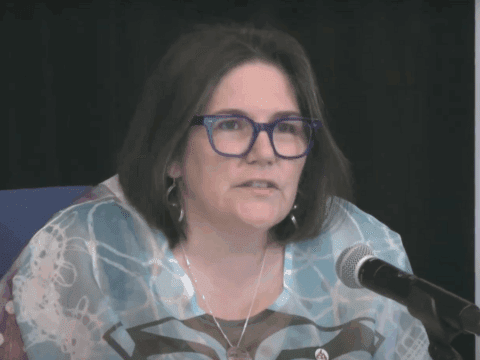The snow-dusted streets running through the Centre at Naramata are quiet, except for dog walkers and pickup trucks heading across town. That’s not unusual in winter, but it contrasts sharply with typical summer days during the centre’s 68-year history, when the nine-hectare United Church education and retreat facility on the southeastern shore of British Columbia’s Okanagan Lake would buzz with hundreds of visitors.
Last summer was different. For the first time ever, there were no paying guests. As management tried to address long-standing deficits by outsourcing work, a strike by about 30 unionized employees — doing food preparation, maintenance, housekeeping and guest-services work — resulted in cancelled spring and summer programs.
The strike stretched beyond fall and into winter. As more programs were cancelled, local restaurants, wineries and shops reported a sharp downturn in business.
Then in mid-January, a bombshell: the centre’s board of directors announced it was closing the facility immediately and laying off management and unionized staff. A successful $500,000 fund-raising rescue mission last November had not been enough to save the centre.
The days of busy, family-friendly summers at Naramata appear to be gone for good. In their place, a couple of tough questions: Could the closure have been averted? And is there a gap between what the United Church preaches about labour justice and what it practises on its own turf?
During the strike, residents of the village of Naramata and centre users, workers and donors were split between support for union and management. Differences still linger, but everyone is united in grief over the loss of a special place.
The centre’s board does not blame the union for the closing, but union members say better management could have solved many problems. According to a board transition team tasked with handling details of the closure, the turning point was simply a hard look at “the Centre’s future operations, revenue potential, staffing plan, expenses, and ability to be financially viable.” The review showed that “the Centre could not continue to operate in a feasible, sustainable, and responsible manner on a long-term basis.”
The business model that the board concluded no longer works developed over several decades. Founded in 1947 as a lay training school using a surplus army building, the Centre at Naramata is today a sprawling complex of 30 buildings, fronting on a private 150-metre stretch of beach. It is owned and operated by the Naramata Centre Society, an incorporated charitable not-for-profit organization.
There are beds for 220 and campsites for 150 more. Secular groups would rent the facility in spring and fall “shoulder” seasons, bolstering income. A smaller group of youth attended winter leadership sessions. But summer programs were the church-oriented heart of Naramata.
More than 2,000 people from British Columbia and Alberta would stay at the centre during an average summer. For many, it became part of a multigenerational family tradition, with daily programs, Wednesday worship and barbecues, and a dance on Friday night.
Doug Woollard, a past chair of the centre’s board, spent seven years of his childhood living at Naramata, where his father, Rev. Clyde Woollard, was the centre’s vice-principal. In later decades, he often returned with his own family. The centre is “part of the fabric of our lives,” he says. “There was just a sense of peace and belonging about the place. And I think that’s what kept people coming back year after year.”
Staff alumni include past moderator Marion Best (she and her husband, Jack, still live in the village) and current Moderator Rt. Rev. Gary Paterson.
Still, the centre consistently lost money — despite hefty annual donations and a sizable endowment fund. By 2013, the centre’s accumulated deficits added up to $1.5 million, and it owed $1.8 million to financial institutions.
In 2012, British Columbia Conference, the United Church court that oversees Naramata, hired Colliers International Consulting to look into the value of the centre’s assets and to suggest ways it could continue to operate. By mid-2013, the report was completed.
“The place has been running on deficits for so long, we had nowhere to go,” says Naramata’s executive director Janet McDonald. The report “basically said, if this were a business, you would be closed.”
With its own finances robust thanks to sales of other church-related properties and a 2013 bequest worth about $700,000 a year, B.C. Conference was in a position to help. In November 2013, its executive agreed to provide up to $4 million in financing. The centre got $2.6 million initially to pay off bank debt, make badly needed repairs and cover any 2014 deficit. It could borrow the rest when annual losses were halted for good.
The centre’s managers called it a “Mom and Dad” loan. A grant from Conference covered the interest — 4.5 percent — until 2017. The only condition, says B.C. Conference executive secretary Rev. Doug Goodwin, “was that the centre had to become solvent within a very short period of time, or show a direction that it would become solvent.”
The value of the centre’s land alone is about $6 million, so B.C. Conference’s investment is safe.
Until recently, the Canadian Union of Public Employees (CUPE) and the Centre at Naramata got along well. Members say unionization 20 years ago was not about money but job security and equal treatment. Even as the strike dragged on last year, they insisted it was still not about money.
Wages averaged about $15 an hour, and only a few of the staff worked full time year-round. At least a third of the workers had been there for more than a decade, and several had been Naramata employees for more than 20 years.
Then came the Colliers study. One of its recommendations was that the centre should look into changing its collective agreement and contracting out some union work. It also suggested the centre consider becoming a non-union workplace.
In the end, the centre’s board and management decided that using non-union contractors to replace unionized workers had to be part of its new business strategy if the facility had any hope of breaking even.
After learning about the centre’s outsourcing plans in late 2013, the union launched a grievance. It was dropped last spring as negotiations began on a new contract. When management proposed a contract that included layoffs to make way for non-union contractors, union members voted to reject it and to strike.
At a policy level, The United Church of Canada has long supported trade unions and collective bargaining. In practice, the church has been less enthusiastic about unionization. An attempt, backed by CUPE, to certify a staff union at the United Church’s General Council Office failed by a narrow margin in 2007. Church managers opposed the move. A decade-plus effort to unionize clergy, initially based on a certification drive in Ontario, has also foundered.
In overseas programs, national church staff have worked closely with labour unions and the Canadian Network for Corporate Accountability. The ecumenical justice coalition KAIROS Canada, which includes the United Church, works with CUPE on environmental and human rights issues overseas; 15 employees at KAIROS’s Toronto headquarters are also represented by CUPE Local 4557. Apart from Naramata, it is the church’s only unionized ministry. “We have a collegial, constructive relationship with CUPE,” says KAIROS executive director Jennifer Henry.
Last summer, CUPE began pressuring the United Church over the strike at Naramata, staging a rally outside the B.C. Conference office in suburban Vancouver and later handing out flyers to worshippers at the tiny Anglican-United community church in Naramata. The centre’s executive director, her spouse, a board member and a former moderator all worship there and didn’t appreciate the intrusion. The flyers, which were also distributed on the picket line, asked people to contact the moderator, Rt. Rev. Gary Paterson, as well as ministers and church officials.
General Council responded, says general secretary Nora Sanders, by telling CUPE that the Naramata Centre Society, not the United Church, owns and operates the centre, and that “the church has no right of approval over the society’s policy and operational decisions, including all employment matters.” Still, the union kept pushing.
In a January interview, Paul Moist, national president of the 628,000-member CUPE, said, “There’s this continual thread of values in the church’s adopted position, that they value the dignity of work. Well, there’s nothing more undignified than telling folks who have been working for you, ‘You’re gone tomorrow, and we’re going to find somebody we can force work on for less money.’”
Last December, after more than seven months on a picket line living on $375 a week in strike pay, workers seemed more saddened than angered by their situation.
“I’m proud of what we’re doing here,” said head cook Colin Drought, who had worked at the centre for 22 years. He and his fellow strikers huddled against winter winds in a worn travel trailer, warmed by electric heaters driven by a gasoline generator. “Social justice is a big thing; it’s a fundamental reason why the place is running,” said Drought. “I’m proud to have learned that here. The irony of it all is not that pleasant.”
Before the strike, the centre was looking into the possibility of creating an intentional Christian community as part of its business plan. But as the strike progressed, the board and management began to see that such a transformation — on a smaller real estate footprint — was the only possible approach.
The models for such communities include Taizé in France, Iona in Scotland, L’Arche homes around the world and Shane Claiborne’s the Simple Way in the United States, according to centre management. Most have social service, peace, community development or social justice as part of their raison d’être.
During the strike, the centre’s five permanent management staff remained on the payroll. Along with three other part-timers — two of whom were trading rent-free accommodation for work — they experimented with the intentional Christian living model, cultivating a large vegetable garden, worshipping regularly and sharing meals.
By last November, with no revenue flowing in but salary and utility expenses adding up to about $40,000 a month, the centre had nearly exhausted its funds. To buy time, the board of directors and management launched the Crossroads Campaign, telling supporters the centre would close by year’s end if $500,000 was not raised in less than a month.
Donors learned about the proposed intentional Christian community but were told it would “operate in tandem with the Centre,” not replace it. Donors were also told the centre had a strategy and enough money to settle the strike.
The campaign succeeded, drawing 464 donors including three B.C. Presbyteries and one single gift of $100,000.
In the end, though, Naramata needed more than money to save itself. Plans for the future monastic-style community on a smaller property were never officially submitted to B.C. Conference or put clearly to longtime centre supporters. Nor was there a long-term financial plan or any certainty that B.C. Conference — currently owed $2.6 million — would approve piecemeal property sales to clear the debt. The decision to close came when the board decided “there were too many hurdles to overcome,” says Sandy Navrady, vice-chair of the Naramata board.
People who donated to the Crossroads Campaign have been offered their money back.
In the midst of the Crossroads Campaign, CUPE applied to have the B.C. Labour Relations Board recognize the Centre at Naramata and The United Church of Canada as a common employer. The union hoped this would force church officials to take an active role in bargaining. At press time, no decision had been released.
Despite the subsequent closure of the facility, the strike continues. Instead of negotiating severance pay, the board and management opted to send unionized workers severance cheques. According to a union representative, the payments are at the provincial minimum — a week per year of service up to a maximum of eight weeks’ pay. The union has advised members, who have up to 25 years of service, not to cash the cheques while it negotiates a better deal.
“The picket line is not down,” says Brenda Lende, a housekeeper at the centre for 14 years and a union shop steward. “We are not going away.”
The centre’s board is not about to disappear either. It remains to be seen whether a new or modified plan for the future will emerge when the Naramata Centre Society holds its annual meeting in June.
“Right now, the board wants the centre closed, to have some breathing room, to decide what’s next,” says Navrady. B.C. Conference, he adds, “have very much indicated that they would like the society to work this out.”
***
This story first appeared in The United Church Observer’s March 2015 issue with the title “Naramata Centre shuts its gates.”














